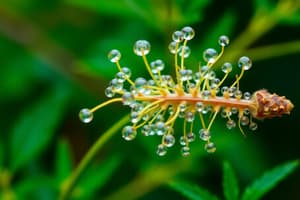Podcast
Questions and Answers
Which discipline studies of the Earth's structure, processes, and evolution?
Which discipline studies of the Earth's structure, processes, and evolution?
- Chemistry
- Physics
- Biology
- Earth Science (correct)
What is the initial step in the scientific method?
What is the initial step in the scientific method?
- Observation (correct)
- Experimentation
- Analysis
- Hypothesis
Which field of science is focused on studying matter and its properties?
Which field of science is focused on studying matter and its properties?
- Chemistry (correct)
- Physics
- Astronomy
- Biology
What is a well-substantiated explanation of some aspect of the natural world, based on repeated observation and experimentation?
What is a well-substantiated explanation of some aspect of the natural world, based on repeated observation and experimentation?
Which SI unit is used to measure mass?
Which SI unit is used to measure mass?
What does the field of biology primarily study?
What does the field of biology primarily study?
Which of the following is the study of the fundamental laws and principles governing the universe?
Which of the following is the study of the fundamental laws and principles governing the universe?
What is the purpose of experimentation in the scientific method?
What is the purpose of experimentation in the scientific method?
Which of these describes descriptive statement that accurately predicts events under certain conditions?
Which of these describes descriptive statement that accurately predicts events under certain conditions?
Which field combines biology and chemistry to study chemical processes within living organisms?
Which field combines biology and chemistry to study chemical processes within living organisms?
Flashcards
Biology
Biology
The study of life and living organisms, including their structure, function, growth, origin, evolution, and distribution.
Chemistry
Chemistry
The study of matter and its properties, including its composition, structure, properties, and how it changes.
Physics
Physics
The study of the fundamental laws governing the universe, including matter, energy, space, time, and their interactions.
Earth Science (Geoscience)
Earth Science (Geoscience)
Signup and view all the flashcards
Astronomy
Astronomy
Signup and view all the flashcards
Scientific Method
Scientific Method
Signup and view all the flashcards
Scientific Theories
Scientific Theories
Signup and view all the flashcards
Scientific Laws
Scientific Laws
Signup and view all the flashcards
Observation
Observation
Signup and view all the flashcards
Hypothesis
Hypothesis
Signup and view all the flashcards
Study Notes
- Natural sciences seek to explain and predict phenomena in the natural world, based on empirical evidence
- Natural sciences use the scientific method to formulate hypotheses and theories tested via observation and experimentation
- Natural sciences serve as the foundation for applied sciences
Core Disciplines
-
Biology is the study of life and living organisms
- Subfields of biology: botany, zoology, microbiology, genetics, and ecology
- Biology investigates living things' structure, function, growth, origin, evolution, and distribution
-
Chemistry is the study of matter, its properties, and how it changes
- Chemistry includes composition, structure, properties, and reactions of substances
- Key areas of chemistry: organic, inorganic, biochemistry, analytical, and physical chemistry
-
Physics studies the fundamental laws and principles governing the universe
- Physics deals with matter, energy, space, time, and their interactions
- Subfields of physics: classical mechanics, electromagnetism, thermodynamics, quantum mechanics, and relativity
-
Earth Science (Geoscience) studies the Earth, its structure, processes, and evolution
- Earth science includes geology, oceanography, meteorology, and environmental science
- It Investigates the Earth's atmosphere, hydrosphere, lithosphere, and biosphere
-
Astronomy studies celestial objects, space, and the physical universe
- It Explores the nature, origin, and evolution of stars, planets, galaxies, and the cosmos
- Subfields of astronomy: astrophysics, cosmology, and planetary science
Scientific Method
-
The scientific method is a systematic approach to investigate natural phenomena
-
Steps:
- Observation: Identify a phenomenon or problem
- Hypothesis: Formulate a testable explanation
- Prediction: Deduce consequences from the hypothesis
- Experimentation: Test the hypothesis through controlled experiments
- Analysis: Interpret results and draw conclusions
- Conclusion: Accept, reject, or modify the hypothesis based on evidence
Theories and Laws
-
Scientific theories are well-substantiated explanations of natural world aspects
- Theories are based on repeatedly confirmed facts through observation and experiment
- Examples: the theory of evolution, the theory of relativity, and the cell theory
-
Scientific laws are descriptive statements that accurately predict events under specific conditions
- Laws are often expressed as mathematical equations
- Examples: the law of gravity, the laws of thermodynamics, and the laws of motion
Measurement and Units
-
Measurement is fundamental to the natural sciences
-
Standardized units ensure data consistency and comparability
-
The International System of Units (SI) is the most widely used measurement system
- SI base units: meter (m) for length, kilogram (kg) for mass, second (s) for time, ampere (A) for electric current, kelvin (K) for temperature, mole (mol) for amount of substance, and candela (cd) for luminous intensity
Data Analysis and Statistics
- Data analysis involves inspecting, cleaning, transforming, and modeling data to discover useful information, draw conclusions, and support decision-making
- Statistics involves collecting, analyzing, interpreting, and presenting data
- Statistical methods assess the significance of experimental results and distinguish real effects from random variation
- Common statistical measures: mean, median, standard deviation, and correlation
- Statistical tests (t-tests, chi-square tests) determine the probability of observed results if there is no real effect
Instrumentation and Technology
- Advances in instrumentation and technology have greatly expanded the ability to study the natural world
- Telescopes, microscopes, particle accelerators, spectrometers, and other sophisticated instruments enable detailed observations and experiments
- Computers and computational methods facilitate data analysis, modeling, and simulation
Interdisciplinary Nature
- Many significant advances in the natural sciences occur at the interface between different disciplines
- Biochemistry combines biology and chemistry to study the chemical processes within living organisms
- Biophysics applies physics principles to biological systems
- Geophysics uses physical methods to study the Earth
- Bioinformatics uses computational tools to analyze biological data
- Environmental science integrates aspects of biology, chemistry, physics, and earth science to study environmental problems
Studying That Suits You
Use AI to generate personalized quizzes and flashcards to suit your learning preferences.




